|
For more information about tourism in the Dominican Republic please visit:
http://www.dominicana.com.do/
Dominican Republic
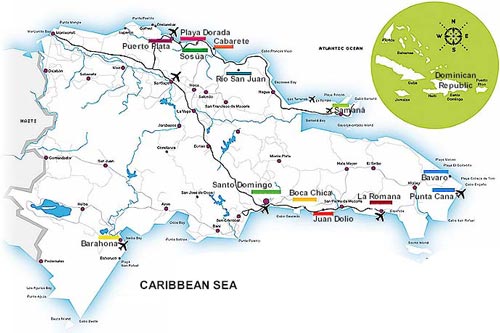
Map Courtesy of: ASONAHORES
www.asonahores.com
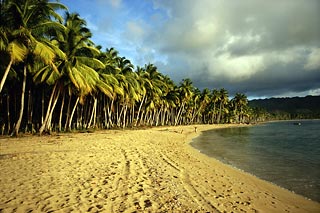
Tourism is, without doubt, one of the most important economic activities of the Dominican Republic and one of the fastest growing in the Caribbean.
According to the statistics of the Central Banck of the Dominican Republic, in 2005 3 Millions 690 tourists visited the country. From January to October 2006 the same source informed that 3 Million 295 tourist had already visited the Dominican Republic.
The tourism boom has prompted a frenzy of hotel construction, particularly along the country’s northern coast, around Puerto Plata and Sosua and the southeastern coast, around Bavaro and Punta Cana. The latest estimates for the end of the year 2006, put the number of hotel rooms in the Dominican Republic at 60, 394.
The availability of hotel rooms and modern facilities to accommodate different interests has helped to make tourism one of the country’s most important industries, earning more than US$2.4 billion on foreign exchange.
For further information, please visit one of the following sites: www.dominicana.com.do; www.drhotels.com; www.dominicanrepublic.com.
The tourist route that begins around Santo Domingo, the capital of the Dominican Republic, has a path that stretches toward the southeast, beginning in San Pedro de Macorís and continuing to La Romana, the ideal complements to enjoy urban beauty with centuries old historical enclaves and kilometers of Caribbean beaches.
Santo Domingo has the privilege of being the first city in the New World and cradle of evangelization in America.
A group of American “firsts” are located in the Colonial City, the first cathedral of America (Catedral Primada de América) the first hospital, the first monastery and the first seat of government, among others, for which the United Nations Educational, Scientific and Cultural Organization (UNESCO) declared it a “World Heritage Site” in 1990. The Colonial City offers multiple possibilities for visits along defined routes, military, civil and religious, where the antique buildings preserve the rich cultural history of the place.
Santo Domingo also has a modern profile as a metropolis that remains in permanent evolution. Stores of accredited international brands, establishments of renowned designs or exquisite artisan motifs compose the wide variety of options, such as the Mercado Modelo, the main center for handicrafts in the country.
Enjoying the tropical climate is another part of the menu offered by the city, with various parks as options for excursions on foot: the botanical garden, the zoo, the National Aquarium and the Parque del Mirador del Sur.
A hotel infrastructure that includes options from the smallest hostels to luxury hotels of reputed international chains allow for a stay full of possibilities, which extends to the nighttime for the plethora of bars and restaurants that guarantee full satisfaction with delicacies and international and Caribbean ambience.
Los Tres Ojos, caverns with subterranean lakes, are part of the sea route that begins on the Autopista Las Américas, which provides access to the Aeropuerto Internacional José Francisco Peña Gómez, and that, in terms of beaches, first reaches Boca Chica, followed by Playa Caribe, the first with tranquil waters and the second with waves that make it a windsurfer’s paradise.
Guayacanes and Juan Dolio continue the quest for sun and beach with the lovely addition of their golf courses in the middle of various hotel complexes and delicious restaurants that look out onto the sea.
San Pedro de Macorís, founded in the early 19th century by Arab and European immigrants, constitutes an urban point on the coast, featuring the attraction of its Victorian and Neo-classic style buildings.
Its cocolo population, black workers that compose the work force of the sugar refineries, has given it a cultural richness particular to the province, in which the Guloyas, or dancing devils, follow a dizzying rhythm in local festivals.
One arrives to La Romana by highway to reach the cattle ranches and sugar cane plantations, the majestic rock world of the Altos de Chavón and the accredited golf courses in the surrounding area.
The Aeropuerto Internacional de La Romana connects with Bayahibe, an old community of fishermen, which is also one of the most important beach enclaves on the island for the beauty of its beaches, bordering the Parque Nacional del Este and its Isla Saona. Palms and white and shining sands are the combination that establishes its charm.
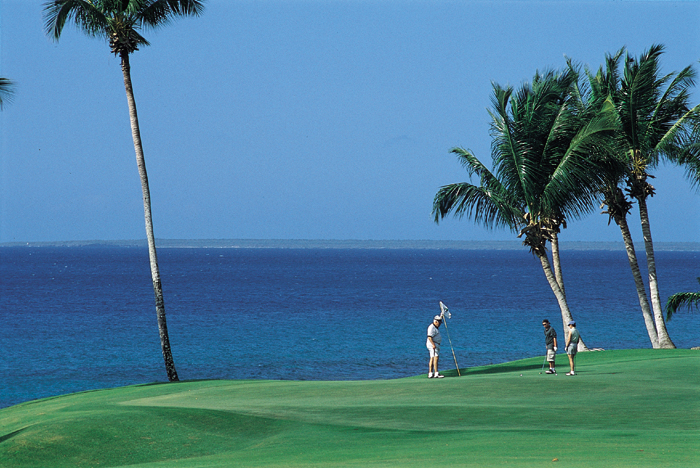
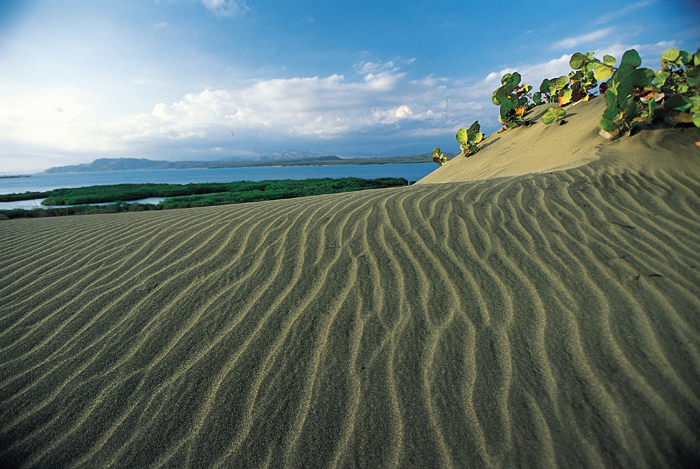
It was more than fifteen years ago that the tourist area of Macao-Punta Cana received the large hotel chains of Europe and put this coastal strip of the La Altagracia province on the global tourism map. The initial attraction, that is, the beauty of its beaches, with time has diversified, with the construction of golf courses and access to natural parks and other areas of ecological interest.
This tourism location encompasses the beaches of Macao, Cortecito, Bávaro, Arena Gorda, Cabezade Toro, Punta Cana and Juanillo, with dozens of uninterrupted kilometers of beaches of fine whit e sand shaded by coconut palms. These beaches have, in addition to their exquisite beauty, multiple attractions in their surroundings. Among them is the Parque Nacional del Este, ecological reserve that possesses the greatest concentration of cave arte in the Antilles. The island Saona, included in the park, is inhabited by a small community of fishermen. It has leafy forests, sandy beaches and marshes that serve as a refuge for a wide diversity of insects, reptiles and birds, many of them endemic to the island. Tortoises and manatees enrich its marine life.
Other attractions for the beach Caín are: the Bávaro lake, the international scuba and fishing areas in Cabeza de Toro, subterranean caverns and rivers, indigenous cemeteries, mountains and hot springs.
The Aeropuerto Internacional de Punta Cana connects the area with America and Europe.
A report by the United Nations Educational, Scientific and Cultural Organization (UNESCO) certified, in 1971, that the coast is one of the best beach areas in the world.
In the principal city of the La Altagracia province, Higüey, the Basílica de Higüey and the Catedral Nuestra Señora de la Altagracia are found, the latter designed by A. Nunoyer de Segonzacy and Pierre Nupré and opened on January 21, 1971. This Basílica was constructed to replace the Viejo Santuario, which became too small to receive all of its parishioners. Christianity arrived for the first time to America with Admiral Christopher Columbus in 1492 and from this island, evangelization of the American continent began.
The church was constructed to venerate the Virgin Mary. Marian worship, under prayers to the Virgin of Altagracia, constitutes the highest form of popular religion for the Dominican people, which has been mixed and associated with our culture, folklore and historical characteristics.
A great canvas of palm forests and beaches of intense blues and white sands, Samaná is an almost unexplored tropical landscape, making it one of the most interesting tourist destinations in the Caribbean region.
Its soil, lined with white, pink, green and gray marble, reminiscent of the Cretaceous period, constitutes one of its principal mineral assets.
Humpback whales arrive every year on its coast from approximately January to March, as they migrate from the Artic regions to procreate and care for their offspring.
Upon arriving to the city, one can make out the coast of "Cayo levantado" surrounded by blue-green, tranquil waters, the perfect contrast to the white sands of the island.
Las Terrenas and Las Galeras are, together with the city of Samaná, the best attractions in the province that, in the Bahía, or bay, de Samaná, features an important historical site. When Christopher Columbus decided to return to Spain to tell of his discoveries to the Catholic Kings, he discovered the Bahía de Samaná, where the first encounter between Indians and Spaniards took place in the New World. The place was named the Gulf of Arrows.
Las Terrenas y Las Galeras son junto a la ciudad de Samaná los lugares de mayor atractivo de la provincia que tiene en la Bahía de Samaná un enclave histórico trascendental. Cuando Cristóbal decidió regresar a España a rendir cuentas de sus descubrimientos a los Reyes Católicos descubrió la Bahía de Samaná , donde se produjo el primer viaje entre indios y españoles en el Nuevo Mundo. El lugar se denominó el Golfo de las Flechas.
In Las Terrenas, the joint work of the natives and foreigners has produced a small tourist city in which the excellent hotel offerings feature small hotels and cabins.
In Las Galeras, the palm forests and untamed beaches have a rural feel that invites relaxation and adventure, in its small lodgings with excellent service.
The "Salto del Limón", a waterfall over 40 meters high and 300 meters above sea leve, is one of its greatest resources. The adventure of experiencing it includes riding a horse up to the waterfall and bathing in the natural pool of the falls.

Located on the northern seaboard of the Dominican Republic, with an area of 1,856 square kilometers, Puerto Plata is one of the Dominican tourist destinations most recognized in the Caribbean for its natural attractions.
Known as the "Amber Coast", its seaboard extends for more than 125 kilometers of mountains and beaches. It was in these lands, in La Isabela, where Admiral Christopher Columbus disembarked on his first voyage. The province also has one of the largest amber deposits in the world.
Puerto Plata is the principal city, full of interesting tourist sites due to its history, its Victorian architecture, its beaches and its tropical landscape. It was founded in 1496 by Bartolomé Colón and is situated at the foot of the Loma Isabel de Torres, a peak that reaches some 902 meters above sea level, which has been declared a national park. One can ascend the peak by a cable car that reaches the summit of the mountain, which is crowned by an imposing statue of Redeemer Christ.
Close to downtown is the Aeropuerto Internacional Gregorio Luperón.
A site of great historical value is the Fort of San Felipe, constructed between 1564 and 1577 to defend the city from the pirates and corsairs that terrorized it. It is a valuable display of the military architecture of the colony.
The center of the city is noted for its Victorian buildings that evoke the romanticism of the city, which reached its height of splendor in the late 19th century, when it was designated the interim capital of the Republic. In the Parque Duarte, place of recreation for citizens and visitors, one can admire a gazebo or "glorieta" of harmonious lines and finely worked wood. From there, one can make out the spires of the Iglesia de San Felipe, a church of the simple and provincial architecture typical of the region.
More than 11 kilometers of beaches supply this area with infinite options to satisfy the most demanding tastes. If one is looking for a popular environment, the Playa de Long Beach, favorite of the citizens of Puerto Plata, faces the boardwalk of the city. To the west of Puerto Plata, the Playa de Guarapito is found, with its half moon shape and crystalline waters, ideal for a day of enjoying sun and surf. The Playa Cofresí is nearby, a small beach surrounded by palms.
The tourist resort of Playa Dorada, surrounded by a spectacular strip of beach protected by coral reefs, is an essential addition to the area and features a golf course.

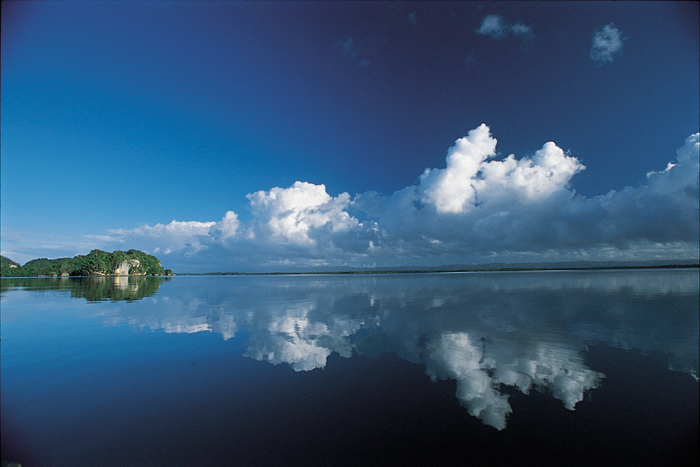
The Río Yaque del Norte runs through the city of Santiago de los Caballeros, the second largest city in the county, with 710,803 inhabitants and an industrial and agricultural foundation that have made it one of the richest communities in the Antilles.
A walk through downtown allows the visitor to appreciate its aristocratic architecture that complements other impressive cultural legacies: the monument to the Heroes of the Restoration, the Catedral Santiago Apóstol and the Plaza de la Cultura.
The Centro León is a required stop, as it is an active cultural stage that, through its visual arts and anthropology collections, offers a spectacular journey through the fundamental components of the Dominican culture and habitat from the time when the island was populated by indigenous people.
An outing in horse-drawn carriage, a direct visit to a cigar factory, together with the Centro León, are all part of the opportunities in the city.
In the province of La Vega, two mountainous areas, Jarabacoa and Constanza, are not only famous for the fertility of their lands. The beauty of their peaks, whose low temperatures allow for unique vegetation, had made them a place of recreation for Dominicans and foreigners.
Jarabacoa, located at 500 meters above sea level, with a population of around 54,981, is named "the city of eternal spring". Its average climate is 22° Celsius throughout the year, which favors the cultivation of strawberries, apples, flowers and vegetables. In the night, the temperature can drop to less than 10°C.
Constanza features a national park, "Valle Nuevo", which is also the highest plateau of the Antilles, at 2,200 meters above sea level. Its exportation crops of potatos and ornamental flowers compose part of its natural richness.
In the city of Constanza, one can observe the "Agua Blanca" waterfall, the highest of the Antilles, named for the color of the water in its fall over the rocky mountain that frames it.
For the beauty of the environment, as well as for its natural conditions, adventure tourism is very present in the community. Extreme sports fans follow the treacherous Yaque del Norte river in rafts, rock climb to rappel down the Baiguate and Jimenoa waterfalls or enter the forests on Jeep, motorcycle or bicycle safaris. Another possibility is to climb to the peak of Pico Duarte, the highest mountain in the Antilles at 3,087 meters above sea level, an activity that is offered with the help of guides and excursions organized by tourism companies. Two of the most important rivers of the country emerge from the mountain: the Yaque del Norte and the Yaque del Sur. The lowest temperatures in the Caribbean are recorded here during the months of December and January, as they arrive at 8°C below zero.
The areas surrounding the peak are the only places in the Antilles where glaciations occurred, according to what scientific research has determined.
The virgen beaches, cays and ports and the Parque Nacional Los Haitises, are all fundamental aspects of the destination, which is a complete package for lovers of ecotourism. The park has a wet forest with a wide diversity of flora and fauna, in addition to caverns that the indigenous peoples of the island inhabited in the period of the Discovery of America. In the caverns, the visitor can see infinite numbers of pictographs and petroglyphs.
From Samaná, one can take the route toward the towns of Nagua and Cabrera of the María Trinidad Sánchez province, located in the Eastern Cibao Region, at some 125 kilometers from the Dominican capital. The Nagua seaboard is a large spa that bathers can enjoy throughout the year. In Cabrera, the Bahía Escocesa boasts shallow waters and soft waves that make it an ideal location for scuba diving. The Parque Nacional Gran Laguna, where mangrove forests abound, is another important tourist attraction.
The beaches of Maimón, Sosúa and Cabarete complete the offerings of this privileged area. In Sosúa, beach and town are both attractions, with intense activity by day and by night.
Cabarete is another attractive beach town, located between a bay and a lake, especially when its winds and cresting waves make it the ideal location for practicing windsurfing. Here, various championships for the World Cup of the Windsufing Association have been held. It is an excellent destination for sports and adventure tourism.
In the municipality of Río San Juan, we find the Laguna Gri-Gri, a fresh water lake from whose soil spring mangroves that cross their roots to trap a canal of mineral water, where they guard treasures, which have turned into a coral bank. The Cueva de las Golondrinas, La Piscina, El Caletón, Puerto Escondido and Playa Grande with its golf course (designed by the architect Robert Trent Jones Sen), give the tourist a sense of the natural magic of this place.
Source: Banco Central, Secretaría de Turismo, Inter-American Development Bank
|